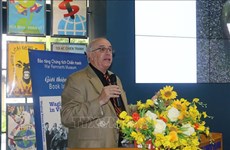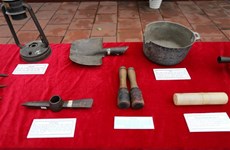Party debates capital city’s socio-economic development
Socio-economic development and construction planning were hot agenda
items at a
meeting of the Hanoi Party Committee on April 8.
Socio-economic development and construction planning were hot agenda items at a
meeting of the Hanoi Party Committee on April 8.
Pham Quang Nghi, the city’s Party Committee Secretary, emphasised the importance of these issues during the meeting.
“They are very important to the capital city’s development because specific planning projects will be outlined from these plans,” said Nghi, who is also a Politburo member.
These projects include the city’s Socio-Economic Development Strategy to 2030 and Vision to 2050; its Master Plan by 2020 with a Vision to 2030 and a Master plan on the Construction of Hanoi by 2030 and Vision to 2050.
Under the draft Hanoi Socio-Economic Development Strategy by 2030 and Vision to 2050, the capital city aims to become the nation’s political, administrative, cultural, economic, international trade, and education and training centre.
The plan calls for the city to invest 60 billion USD in socio-economic development projects from 2011-15 and another 98 billion USD from 2016-2020.
Thanh Tri district’s Party Committee Secretary Trieu Dinh Phuc said the city is not developing in a very sustainable way. Big international organisations are not choosing to open headquarters here because Hanoi was still focuses on quantity over quality when seeking foreign investments, he said.
Deputy chairman of the Hanoi Fatherland Front, meanwhile, said planning projects must clarify which areas of land would be earmarked for urban development, agriculture production, industry and others.
Nghi said it is essential to combine Hanoi’s development strategy with its master plan on socio-economic development.
Hanoi is aware that as a developing economy, culture and society, it is crucial to consider urban management as an important and regular part of its mission.
The city aims to attain annual average Gross Domestic Product (GDP) growth of between 9 percent and 10 percent during the 2011-20 period, and between 7.5 percent and 8.5 percent from 2021-30.
Service and industry will account for more than 98 percent of the new economic structure by 2030. More than 85 percent of the city’s labourers will receive training by the same year.
The plans also call for Hanoi to become a green, civilised and modern urban area. It will comprise a nuclear urban centre and the five satellites of Son Tay, Hoa Lac, Xuan Mai, Phu Xuyen – Phu Minh and Soc Son./.
Pham Quang Nghi, the city’s Party Committee Secretary, emphasised the importance of these issues during the meeting.
“They are very important to the capital city’s development because specific planning projects will be outlined from these plans,” said Nghi, who is also a Politburo member.
These projects include the city’s Socio-Economic Development Strategy to 2030 and Vision to 2050; its Master Plan by 2020 with a Vision to 2030 and a Master plan on the Construction of Hanoi by 2030 and Vision to 2050.
Under the draft Hanoi Socio-Economic Development Strategy by 2030 and Vision to 2050, the capital city aims to become the nation’s political, administrative, cultural, economic, international trade, and education and training centre.
The plan calls for the city to invest 60 billion USD in socio-economic development projects from 2011-15 and another 98 billion USD from 2016-2020.
Thanh Tri district’s Party Committee Secretary Trieu Dinh Phuc said the city is not developing in a very sustainable way. Big international organisations are not choosing to open headquarters here because Hanoi was still focuses on quantity over quality when seeking foreign investments, he said.
Deputy chairman of the Hanoi Fatherland Front, meanwhile, said planning projects must clarify which areas of land would be earmarked for urban development, agriculture production, industry and others.
Nghi said it is essential to combine Hanoi’s development strategy with its master plan on socio-economic development.
Hanoi is aware that as a developing economy, culture and society, it is crucial to consider urban management as an important and regular part of its mission.
The city aims to attain annual average Gross Domestic Product (GDP) growth of between 9 percent and 10 percent during the 2011-20 period, and between 7.5 percent and 8.5 percent from 2021-30.
Service and industry will account for more than 98 percent of the new economic structure by 2030. More than 85 percent of the city’s labourers will receive training by the same year.
The plans also call for Hanoi to become a green, civilised and modern urban area. It will comprise a nuclear urban centre and the five satellites of Son Tay, Hoa Lac, Xuan Mai, Phu Xuyen – Phu Minh and Soc Son./.













